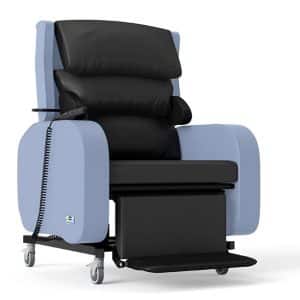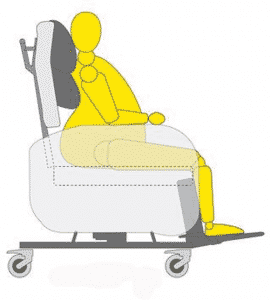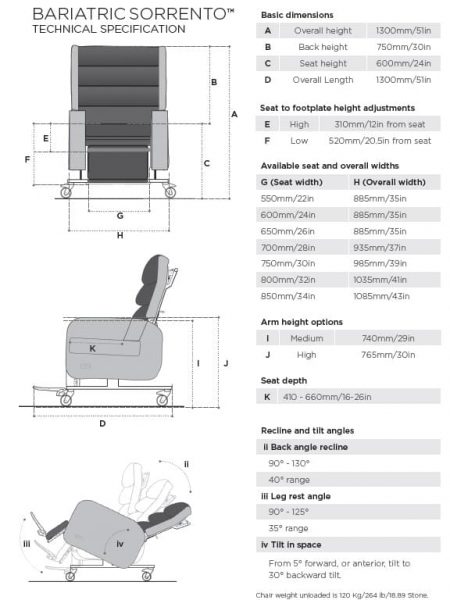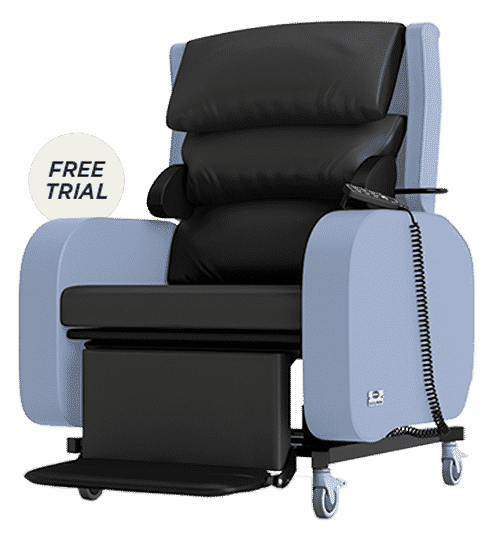"Seating a bariatric person is complex and there are many factors to consider. It’s not as simple as providing a wider chair!"
Martina Tierney OT
How to safely seat bariatric patients
Seating bariatric patients presents many challenges to both the patient and caregivers. A lack of planning and proper equipment can significantly increase the risk of manual handling injuries, pressure damage and increased length of stay.
Before selecting a chair, the weight of the client, their body proportions, physical dimensions, range of movement, mobility and transfers need to be carefully considered. Additionally, the needs and safety of caregivers must be taken into account.
Common Mistakes and Challenges:
Not getting correct measurements
The most common challenge when seating patients with a bariatric condition is getting the measurements of the patient correct.
This can be often a daunting task and clinicians may require extra help to make sure the measurements are as accurate as possible.
It is always better to take extra care getting the measurements right and the chair set up correctly first time around.
Adjusting the chair when the patient is already seated in it can be very difficult and cause manual handling risks. Additionally, it is beneficial to everyone involved that unnecessary transfers to adjust the chair or the patient’s position are minimised.
Not accommodating the Gluteal Shelf
The presence of a gluteal shelf, or bulbous gluteal region in some bariatric patients can make it more difficult to give patients the full back support that they need. The extra tissue in the posterior lumbar region often forces patients to sit forward in their chair, which leaves their back unsupported. This position can be dangerous, causing long term postural complications and also making the patient feel as if they are being pushed forward.
Not accommodating the Gluteal Shelf increases the risk of patient falls.

Incorrect Seat Depth and Seat Height
A patient is more at risk of developing pressure injuries in interface areas if the seat is not making maximum contact to load the body. Improper loading can lead to an uneven distribution of weight on interface areas. The seat depth and seat height needs to be adjusted to match the patients’ leg length but must be at an appropriate length so as to avoid pulling the patient forward and into a sacral sitting position.
No Footplate to support the feet
On the few bariatric chairs that do have tilt in space, they often do not come with appropriate footplates. Approximately 19% of a person’s weight is exerted through the feet in sitting, a key area prone to pressure injury development. However, with patients who have a bariatric condition, this percentage can be greater due to the weight of the abdomen resting on the legs. When chairs do not have footplates and are reclined or titled, you are actually increasing the interface pressure instead of decreasing the pressure the patient experiences.
Not supporting the patient’s feet can lead to sliding from a chair. This increases pressure damage risks from shear and friction as well as being a falls risk.
Not Accommodating Calves
The correct leg rest and calf pad is an important function to consider in seating patients who have a bariatric condition. With larger calves, there is often increased risk from falls during standing as the feet can be positioned far in front of the patient when the calf pad does not accommodate the mass of the patients’ legs. The leg rest must accommodate larger calves to help maintain a typical 90 degree knee flexion posture, and to enable a safe, stable standing position.
No Back Angle Recline or Tilt in Space
It is well known that tilt in space can aid repositioning, improve respiration and reduce the risk of pressure injuries. For patients with a bariatric condition who have decreased mobility and other medical issues, often the need for tilt in space is magnified but many bariatric chairs do not provide this important function.

INTRODUCING THE SEATING MATTERS BARIATRIC RANGE
- 45 degrees Tilt-in-Space
- High Pressure Care
- For People up to 294kg
- Fully Electric Controls
- Infection Control Compliant
- Completely Adjustable
Occupational Therapist and world seating expert, Martina Tierney, designed the Bariatric Sorrento
The Bariatric Sorrento has been designed to provide pressure care and postural support to bariatric patients
The Bariatric Sorrento is has electric tilt, recline and leg rest to reduce risk of injury to
The Bariatric Sorrento has been designed to reduce the risk of injury to the patient and caregiver. Fully motorised to limit patient handling, the Bariatric Sorrento fully accommodates the user’s unique body shape which limits sliding, provides postural support and repositioning. Removable arms also assist with side transferring or sling application and removal
The Bariatric Sorrento chair takes into consideration the weight of the client, the body proportions, physical dimensions, range of movement, mobility and transfers. The needs of caregiver safety are incorporated into the design of the chair. With its adaptability and effortless adjustment, the Bariatric Sorrento can be adjusted to suit the changing needs of a user or re-adjusted to suit the needs of a new user meaning their comfort, posture and pressure management remain uncompromised. Removable arms can assist with side transferring or sling application and removal.
Available to purchase or rent - Hospital, NDIS, Home / Aged Care.
Listed on NSW Health Contract CF820 for rental and purchase





FEATURES
The Bariatric Sorrento has;
700mm or 850mm seat width as standard with the ability to adjust smaller or larger in both models.
Removable bottom cushion to accommodate Gluteal Shelf.
Tilt in space to allow for re-positioning for pressure care and comfort of the user. Elevating leg rest and recline are also standard.
Dartex multi stretch pressure management materials throughout all patient contact surfaces. This material is breathable with moisture permeability to ensure that the surface remains dry and comfortable for the user. This material can be wiped down for infection control and hygiene requirements.
Medium to high pressure management cushion, using memory foam. This cushion is removable for cleaning and if you wish to use a different type. An advantage of our memory foam cushions is they do not require maintenance or adjustment for each person, unlike a gel or air cushion. The cushion is also easily replaceable.
Adjustable seat width, foot plate height and seat depth allows the chair to fit the size and requirements of the user.
A light weight frame with directional castors to allow the chair to be easily pushed in a straight line or moved throughout a small room.
SUITABLE FOR THESE CONDITIONS
- Weight of up to 294kg.
- Pronounced gluteal shelf.
- Reduced mobility.
- Low muscle tone.
- Abducted lower limbs.
- High fluid retention.
- Joint and muscle contractures.
- Osteoarthristis.
- Spinal cord injury.
- Head injury.
- Stroke.
- Multiple sclerosis.
- Parkinson’s disease.
- Dementia.
- Alzheimer’s disease.
MAIN USES
NDIS/Home Care – Care Facilities
Suitable for patients with brain injury, stroke, or any type of non ambulant bariatric person requiring pressure care and comfort.
Hospital
Suitable for patients Useful for those in high dependency wards at risk of pressure injury. Eg; HDU ward, surgical wards, general medical wards, geriatric medicine, stroke and neuro, transitional care and acute care.
PARTS & ACCESSORIES
- Horseshoe pillow.
- Concave pillow.
- Head pillow.
- Lateral supports.
- Leg laterals.
- Legrest wedge.
- Padded arm covers.
- Removable arm covers.
- Padded footplate.
- Fibre-filled footplate.
- Removable seat covers.
- Seat belt.
- 2- Point belt.
- 4-Point belt.
- Four braked castors on chair.
- Inclinometer
As used by









Bariatric High Back Chairs & Tilt In Space Seating
Many people throughout Australia require professional care as a result of their size and weight. The complications that arise from such conditions make life incredibly challenging, particularly where support and mobility are concerned.
Even if a chair is acquired that can support such patients, the reality is that their specific needs and requirements demand something that has been designed and manufactured to afford them a quality of life standard that affords them dignity and comfort. There are many bariatric chair options on the market, but none compare to those created by the team here at Seating Matters.
Bariatric Chairs for Superior Support and Mobility
Our chairs have been developed and created by a specialist group led by Martina Tierney, a world-leading expert on Occupational Therapy and seating. We strive to change the world through healthcare seating that is easy to use, designed to provide exceptional comfort and functionality and that reduces expenditure on caregivers.
The reality is that those with significant weight issues will inevitably spend many more hours per day in bed or in a sitting position. This increases the chances of secondary complications developing, which makes each day a painful, uncomfortable challenge. As an ISO 9001 Quality Management System approved company, we have undertaken considerable efforts with regards to research, design and development to create bariatric chairs that afford users the highest standards of comfort and quality.
An adaptable solution for bariatric seating
Whether you or your patient or loved one, requires a bariatric high back chair our Bariatric Sorrento chair is the ideal choice for a much-improved future. This chair can support patients that are up to two hundred and ninety-four kilograms in weight. It is fully motorised, can accommodate the unique body shape of any patient and is designed to promote better posture, support repositioning and limit sliding. Removal arms make the process of sling use and side transferring much less challenging.
Here at Seating Matters, we believe that adaptable solutions are essential when it comes to bariatric seating. We appreciate that each patient has their own needs and requirements, which means that our chairs must be flexible enough in use to afford them the dignity and sense of comfort and confidence that they are entitled to.
We also understand that patients with considerable weight are at a greater risk of infection. As such, all of our chairs have modular parts, which ensures that those responsible for care can completely dismantle them, leaving no areas unexposed or impossible to clean. They are upholstered in a hard-wearing, enduring contract vinyl that counteracts the vast majority of bacteria, as well as MRSA, E.Coli and C.Difficile.
Our extensive development process and dedication to creating a better standard, along with the clinical evidence that shows our chairs can help prevent pressure injuries and sores.
Take the Pressure Off & Buy a Bariatric Chair
At Seating Matters, we want all those who use our chairs to find the support, pressure care, safety and comfort that they have craved for so long once they finally try our brand. A bariatric chair with a tilt in space feature makes life so much easier for all those that are engaged in the care of any patient and with our chairs, you gain a product that has been manufactured to the highest standard and comes with a 7-year frame warranty.
Our unparalleled bariatric chairs are fast becoming the go-to solution that many facilities choose, including Anglican Care, Baptist Care, NDIS, NSW Government, Uniting Care Australia, Regis and Allity. Book for a free trial or a free seating assessment today and take the pressure off your patients.
Seating Matters provides clinical healthcare seating chairs for Disabled & Elderly people in Australia. We sell kyphosis chairs, pressure relief chairs, cerebral palsy chairs, occupational therapy chairs, parkinsons disease chairs, tub aged care chairs, tilt space chairs, fall prevention chairs, motor neuron chairs, multiple sclerosis chairs, brain injury chairs, Paediatric chairs & other seating range in Australia. Browse our website for more information or contact us for more details.
Read Less




